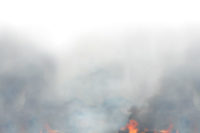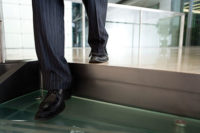
Various studies have been conducted in industrial environments to assess situations that most often contribute to slip-and-fall accidents. Among the findings:
Housekeeping
Of course, the cleanliness of a floor is a major concern. No matter how careful workers are, what type of floor is installed, or what slip protection is applied to the floor, if the floor is not cleaned and maintained well, it will be slippery. And if the floor is slippery, the chances of an accident occurring are high.Many food-processing and industrial floors are cleaned using powerful cleansers or degreasers that are mopped onto the floor. To remove excess soil and buildup, custodians often use a deck brush to loosen grit. They then mop the floors with clean rinse water or hose them down to remove the chemicals and debris. If they mop the floors, it is not uncommon that they have to repeat the process.
In many settings, they also machine scrub the floors regularly, if not daily, usually using a standard rotary floor machine and scrubbing pad. The goal is to remove as much debris from the floors and grout areas as possible to improve safety and reduce the possibility of slip-and-fall accidents.
But as the pad becomes soiled, it can actually spread dirt and soils into pores and grout areas. These soils can build up and result in a slip and fall.
Newer floor care technologies have been introduced that appear to alleviate this problem, more thoroughly clean industrial floors, and help to reduce slip-and-fall accidents. Instead of using pads, these machines use cylindrical brushes that penetrate the textured areas of the floor, pores, and grout to remove grease, grit, and soils.
“Unlike conventional round or rotary buffers, cylindrical machines have counter-rotating brushes on each side of the machine rotating at more than 1,000 rpm at 3.5 pounds per square inch,†says David Frank, president of the American Institute for Cleaning Sciences, Highlands Ranch, Colorado, an independent testing organization for the cleaning industry. “Although these machines weigh as much as a conventional buffer, they have six times the contact pressure, which also improves their ability to deep-clean floors.â€
Forty-one percent of all workers’ compensation costs are attributed to slip-and-fall accidents, according to the National Floor Safety Institute. Textured floors, proper footwear, improved safety procedures, and proper cleaning are all essential to prevent these costly injuries. Newer floor care technologies are now available that help improve worker safety, which in turn helps improve productivity and the employer’s bottom line.

